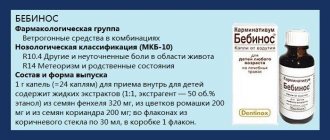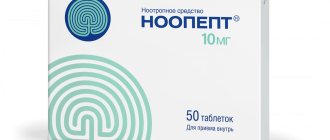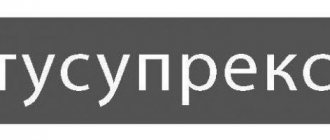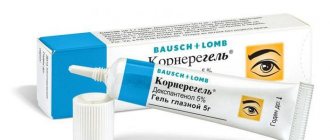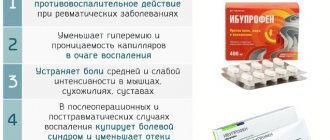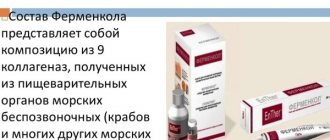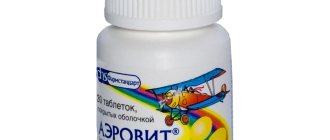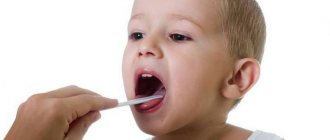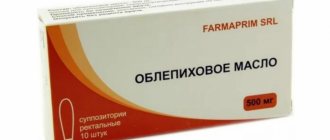Release form and composition
The drug is produced in the form of a homeopathic syrup, which is a transparent thick liquid from light yellow to light brown in color with a specific characteristic odor (100 ml in polymer bottles, one bottle in a cardboard box and instructions for use of Passambra Edas-306).
Composition per 100 g of syrup:
- active ingredients: Ambra grisea C6 – 2 g, Valerianae tinctura (Valerian alcohol tincture) – 4 g, Passiflora incarnata C1 – 2 g, Pulsatilla pratensis C9 – 2 g;
- auxiliary components: purified water, sucrose.
What is more effective Tenoten for children or Edas 306?
Tenoten for children is available in lozenges. They can be given to patients over 3 years of age with neuroses and hyperactivity. Tablets are contraindicated if their composition is intolerant. The doctor should decide which drug is best depending on the indications and contraindications. Tenoten and Edas-306 are homeopathic medicines, that is, medicines with unproven effectiveness. No good doctor will prescribe these medications.
You can read more about the drug Tenoten here.
Contraindications
Absolute:
- isomaltase/sucrase deficiency, glucose-galactose malabsorption syndrome, fructose intolerance (since the syrup contains sucrose);
- pregnancy period;
- breast-feeding;
- children under 1 year of age;
- hypersensitivity to the main or auxiliary ingredients of the drug.
Relative (Passambra Edas-306 syrup is used with caution, since the syrup contains ethanol):
- liver diseases;
- diabetes;
- epilepsy;
- brain diseases;
- traumatic brain injuries;
- alcoholism;
- children's age from 1 year.
Contraindications and side effects
According to the instructions, Edas 306 soothing syrup for children is contraindicated in case of hypersensitivity to its composition. In this case, it can cause an allergy, which requires discontinuation of the homeopathic remedy and adjustment of the further treatment regimen.
Children with diabetes can be given the drug after consultation with a doctor.
Soothing syrup for children Passambra Edas 306 does not cause addiction when used for a long time, physical and mental dependence. After completion of therapy, there is no “withdrawal syndrome” - a deterioration in the child’s well-being after stopping taking a homeopathic remedy.
The drug does not cause an overdose.
If, while taking the medication Passambra Edas 306, a child experiences side effects that are not described in the instructions, you should consult a doctor.
Passambra Edas-306, instructions for use: method and dosage
The syrup is taken orally, between meals. The bottle must be shaken before each use.
Recommended doses of Passambra Edas-306 for children and adults (unless otherwise prescribed by a doctor):
- children aged 1 to 3 years: 0.5 teaspoon three times a day;
- children and adolescents aged 3 to 15 years: 1 teaspoon three times a day;
- adolescents over 15 years of age and adults: 1 dessert spoon three times a day.
The duration of the course is from 2 to 4 weeks.
Indications for use
It is recommended to give the homeopathic remedy Passambra Edas 306 to children if they have the following health problems:
- difficulty falling asleep, waking up at night, daytime sleepiness;
- irritability, aggressiveness;
- emotional excitability, with frequent mood swings;
- psychoneuroses, which are manifested by headache, dizziness, chest pain, decreased or increased blood pressure, increased heart rate, attacks of suffocation, a feeling of lack of air, fatigue, lack of appetite, diarrhea or stool retention, bloating, urinary incontinence;
- nervous excitability, which is observed during teething or after an infection.
special instructions
There was no withdrawal syndrome or addiction to the drug. Sometimes, when using homeopathic medicines, a primary deterioration (transient exacerbation of existing symptoms) may occur, requiring temporary cessation of treatment and consultation with a specialist.
The content of absolute ethyl alcohol in Passambra Edas-306 syrup: in 10 ml of the drug (maximum single dose for adults) – 0.62 g; in 30 ml (maximum daily dose for adults) – 1.87 g.
Information for patients with diabetes: 10 ml of syrup (single dose for adults) contains approximately 8.4 g of sucrose (this corresponds to 0.7 XE).
Impact on the ability to drive vehicles and complex mechanisms
During treatment, patients should be careful when driving vehicles and performing other work that requires a high concentration of attention and a quick psychomotor reaction.
Reviews
Before giving Passambra Edas 306 syrup to children, it is recommended to read reviews about it left by parents who used the homeopathic remedy and Dr. Komarovsky’s opinion about it. Be sure to read the article about what homeopathy is.
Parents' opinion
- A large number of reviews from the Internet look bought.
- Some parents who gave their children Passambra Edas 306 syrup were satisfied with the homeopathic remedy. It has a sweet taste, so children drink it with pleasure. Parents who gave their children Edas 306 syrup during teething noted that their children's daytime and night sleep normalized, they fell asleep faster, while they did not experience lethargy, they remained just as active. According to them, after the first week of taking it, irritability disappeared and hysterics stopped. Perhaps natural processes occurred in the body and the effect of self-hypnosis in the parents worked.
- Some parents don't like that the syrup smells like valerian and can cause an allergic reaction.
- Another part of the people became convinced that homeopathy does not work. In such reviews you can often find the words “absolutely ineffective.”
Doctor Komarovsky's opinion
Evgeniy Komarovsky believes that a homeopathic remedy has the same effect as a “placebo,” that is, a substance that does not have a therapeutic effect. Homeopathy was proposed in the late 18th century by the German physician Samuel Hahnemann. The meaning of his treatment was as follows:
- If a substance in large dosages causes signs of a disease, then in small quantities it will treat this pathology. For example, quinine, which is an alkaloid of the cinchona tree, provokes fever and other symptoms resembling malaria, which means that if taken in small doses, it will cure this disease.
- Very small dosages are used for treatment. To do this, some substance is repeatedly diluted with water, which must be shaken vigorously. This is done so that the liquid remembers the beneficial properties of this substance, and the component itself is present in it in small quantities. Homeopathic remedies may contain a substance that is diluted to 100400; it happens that due to endless dilutions they do not contain a single molecule of the original substance. Next, the water, which has retained its beneficial properties, is combined with powdered sugar. Balls are made from the resulting mass and given to the patient. Homeopathic drops, syrups, ointments, suppositories, and injection solutions are made using the same principle.
Modern science cannot explain the mechanism of action of homeopathic remedies, nor can it prove their effectiveness. Dr. Komarovsky believes that when using drugs such as Passambra Edas 306 syrup, it is not the medication that cures, but faith.
Despite the fact that you can buy Passambra Edas 306 syrup without presenting a prescription, you cannot give it to your child without consulting a doctor. Only a specialist can decide whether it is advisable to prescribe a sedative and select an adequate treatment regimen.
By
Reviews about Passambre Edas-306
According to reviews, Passambra Edas-306 is a good remedy for relieving children's excitability and hysterics, and also helps adults with sleep disorders and stress. Children and adults' sleep normalizes, they become calmer and less excitable. The drug acts gently, has a natural composition, sweet and pleasant taste. The cost of syrup is quite low.
Among the disadvantages, users most often note the overly sweet taste of the drug and weak effect, that is, in case of serious violations, the drug is ineffective.
Description
Passambra Edas-306 is designed for children and adults as a sedative. This is a homeopathic remedy that is available in syrup. It is a clear, thick liquid that smells like valerian. Its color can vary from pale yellow to yellow.
By the way, we recently wrote about whether valerian can be given to children - see here.
Passambra Edas 306 syrup has the following composition of medicinal components:
- Passiflora . Another name for the plant is passion flower. Its active components have a calming effect and help overcome stress. Eliminates symptoms of emotional arousal such as headaches and sleep disturbances. Passionflower normalizes the level of sex hormones in the body, prevents attacks of bronchial asthma, involuntary muscle contractions, and reduces cravings for alcohol and cigarettes. It helps with nervous excitement and insomnia.
- Amber grisea . This substance is formed in the intestines of the sperm whale. It has a positive effect on the nervous system, endocrine glands, and digestive organs. It normalizes sleep; while taking it, the child remembers new information better, and memory problems caused by chronic fatigue disappear. It is recommended to take it for restlessness, anxiety, involuntary twitching of muscles, impaired thinking, weakened memory, insomnia, shallow sleep, nightmares.
- Pulsatilla . This plant is known under such names as meadow lumbago, dream grass, snowdrop. Its active components relieve inflammation, increase immunity, exhibit antimicrobial activity, promote sputum discharge, have a hepatoprotective and diuretic effect, and eliminate signs of depression. It is recommended to take it when mood swings are observed, irritability and tearfulness are replaced by cheerfulness, as well as when there are difficulties falling asleep.
- Valerian tincture . It has a sedative and hypnotic effect. Helps normalize sleep, cope with depression, anxiety, headaches, hysterics.
In addition to these, Edas 306 syrup contains refined sugar and water as additional components.
Methods for correcting neurotic manifestations in children
Neurotic manifestations are one of the most common disorders of the nervous system in children. The share of these disorders is 35–40% of all functional consequences of perinatal hypoxia [1–5]. The wide syndromic range and frequent recurrence of neurotic manifestations require special attention to this cohort of patients not only from neurologists, but also from pediatricians, teachers, and psychologists. In addition, such patients usually require long-term comprehensive medical and psychological support. According to the literature, over 64% of these children have more than 1 episode of exacerbation, about 42% of children have 3 or more episodes of neurotic manifestations [3, 4, 6–8]. Such statistics indicate the insufficient effectiveness of medications used to correct these disorders, which reduce the quality of life not only of the child, but also of his family [5, 6, 9–16]. Of course, dysfunction of the nervous system clinically manifests itself during important periods of a child’s life, such as primary socialization in kindergarten and the beginning of school. At this time, the body undergoes a restructuring to the conditions of the new society, and the functional failure of the nervous system does not allow one to safely pass this period [8, 17–24]. Therefore, the search for new safe and effective therapies is an important task of modern medicine. In this regard, the purpose of our study was a comparative study of the use of several drugs used to correct neurotic and emotional disorders in children.
Material and methods
We observed 131 patients (72 (54.9%) boys and 59 girls (45.1%)) with neurotic manifestations aged from 3 to 12 years. During the diagnosis, a clinical assessment of the neurological and somatic status, neuroimaging (MRI of the brain), electroencephalography, transcranial Dopplerography of cerebral vessels, assessment of the emotional and psychological state using the Luscher test and the CMAS anxiety scale (for children over 8 years of age - The Children's Form)
of Manifest Anxiety Scale modified by A.M. Prikhozhan 2002) [9, 10, 25, 26]. Biochemical and clinical blood tests were performed. All children were examined by a speech therapist-psychologist, ophthalmologist, and pediatrician. Using a random sampling method, patients were divided into 3 groups: the 1st (44 children) received correction with the drug Phenibut at a dose of 0.25 to 0.5 g/day, the 2nd (44 children) - with the drug Nervohel (“Heel”, Germany), 3rd (43 children) – with the drug Valerianahel (“Heel”). The initial data in each group were taken into account differentially. The drug phenibut (Olainfarm, Latvia) consists of two active substances: aminophenylbutyric acid (a phenylethylamine derivative with a tranquilizing effect) and gamma-aminobutyric acid (GABA) (with a nootropic effect). Excipients include: lactose, potato starch, low molecular weight polyvinylpyrrolidone, calcium stearic. The dose ranged from 0.25 to 0.5 g/day. The homeopathic drug Nervohel (Heel, Germany) consists of 6 components (Table 1), each of which has a specific effect on the body. The drug is used from the age of 3 for the treatment of neurotic disorders of various types. We prescribed to our patients, depending on age, from 1 to 3 tablets/day for 14 days without meals.
The drug Valerianahel (Biologische Heilmittel Heel, Germany), like Nervohel, has a mixed composition (Table 2), which causes a versatile effect not only on the nervous system, but also on the body as a whole. Dose for children from 2 to 6 years old - 5 drops 2-3 times / day, from 6 to 12 years - 10 drops 3 times / day for 2 weeks.
In all groups, children received medications according to age recommendations. The effectiveness was assessed using a control clinical examination, extra- and intracranial Doppler examination of cerebral vessels, EEG, testing using the Luscher and CMAS methods before and after therapy. Statistical processing of the study results was performed using the Statistica 22.0 software package (StatSoft Inc., USA), differences were considered statistically significant at p≤0.05.
Results and discussion
The nosological structure of the pathology in 131 patients was represented by the following functional disorders of the nervous system (Table 3): 39 children (29.8%) had disorders of the emotional sphere, 92 (70.2%) had various types of disorders of a neurotic nature. It should be noted that basically these manifestations debuted at the age of 2.5–3.5 years, when children underwent primary social adaptation (kindergartens, development groups, etc.).
A comprehensive diagnosis of all children with NES and NP showed that the greatest disturbances were observed during transcranial Doppler sonography, which characterizes the blood supply to the brain. All patients demonstrated various changes in blood flow through the great vessels and vertebral artery and into the venous outflow. There was a significant decrease in blood flow in the anterior and middle cerebral artery by 32±3.7 and 28±2.4% (p≤0.05 compared to the norm), impaired venous outflow by 38±4.6% (p≤0. 03), aggravated by loads on average 1.4 times compared to the initial values. All patients had insufficiency of the regulatory function of the autonomic nervous system of a mixed type (68.9%) or with the dominance of sympathicotonia (31.1%) with signs of tension in adaptation processes. In 31% of children, neuroimaging changes were detected in the form of mild residual ventriculomegaly. According to EEG data, 73.5% of patients showed disorganization of the bioelectrical activity of the brain in the form of irregularity of the basic rhythm, dysfunction of the median structures, and in 16.1% of them - paroxysmal activity. According to laboratory data, clinical and biochemical blood tests did not reveal any significant differences from the age norm. According to the Luscher color test, disturbances in the emotional, communicative and volitional spheres were noted. By sequential preferential color selection, the following disorders were verified in the observed patients (Fig. 1): in 32% - changes in emotional balance (although clinical changes were noted in 29.9%), in 27% - impaired motivation, in 43% - communication problems , sleep or falling asleep problems (54%), 81% had phobias and anxiety. When analyzing anxiety (according to the CMAS scale from 8 years old) during testing on 53 points, 3 levels of anxiety were identified: slightly increased (41%), clearly increased (36%) and very high (23%).
According to Doppler ultrasound after 2 weeks. after therapy, patients in group 1 receiving phenibut showed positive dynamics in the form of improved venous outflow in 34% and improvement in autonomic support in 36.3%, with a trend toward normalization. No reliable changes in blood flow velocity in the great vessels were obtained. In group 2 (Nervohel), a positive effect was observed in 16 (37.2%) patients in the form of a decrease in functional spasm in the vertebral artery and an improvement in venous outflow, which clinically neutralized tension cephalalgia in children. No significant changes in autonomic regulation were obtained. In group 3 (Valerianahel), an improvement in blood flow velocity in the great vessels was recorded in 19% and normalization of autonomic support in 25.6% of patients. Patients of all groups did not demonstrate significant changes in the EEG, however, on average, 1/3 of patients (36.3% in the 1st, 41% in the 2nd and 30.2% in the 3rd) showed positive changes in the form reducing irritation of cortical-subcortical structures. Positive changes were noted in the reduction of neurotic conditions (Fig. 2, Table 4) and emotional disorders in group 1 (phenibut) in the form of leveling anxiety and phobias in 38.6% of patients, improving sleep in 52.3%. Also, 20.5% of children in this group had improved communication skills, and 38.6% showed a tendency towards normalization of the emotional sphere.
Patients of groups 2 and 3 showed the following results: in 41.9% of children taking Nervohel, anxiety and phobic manifestations decreased, in 25.5% communication skills improved, and in 46.5% their emotional background improved. Among children receiving Valerianahel, anxiety-phobic disorders were leveled out in 34%, sleep disorders in 45.4%, communication skills improved in 18.2%, and emotional background in 23% of patients. The onset of the effect was recorded on days 5–7 of therapy in group 1, from days 4–5 and days 3–4 in groups 2 and 3, respectively. After 2 weeks After therapy, patients showed almost the same results; there was a significant difference between the indicators immediately after treatment and after 2 weeks. after that it was not received. Thus, the effectiveness of homeopathic drugs used to treat neurotic manifestations and emotional disorders is practically no different from the effectiveness of the allopathic drug phenibut (Table 4). Each of the drugs had “its own point of application,” which was most likely due to their composition and mechanism of action. In the correction of sleep disorders, all drugs showed almost identical effectiveness, which made it possible to normalize the process of falling asleep and staying asleep in 44.2–52.3% of children. Nervochel demonstrated the greatest effectiveness in influencing the emotional sphere, as well as in increasing motivation (like phenibut) and communication. Good tolerability of complex homeopathic preparations was also noted - only 2 patients experienced allergic manifestations while taking Nervohel and Valerianachel, which were regarded as a homeopathic “exacerbation”, since they were leveled out independently. In addition to improving the neurological status, 18.6% of patients taking Nervohel and 20.5% taking Valerianachel showed a reduction in dysfunctions in the gastrointestinal tract and urinary system.
Conclusion
Correction of changes of an emotional and neurotic nature requires active and, often, long-term medical intervention. The range of drugs used in the treatment of these disorders is quite wide, but many of them have serious side effects. This fact certainly motivates pediatricians to search for new safe drugs. After the official recognition of homeopathic methods of treatment and permission for their use in traditional medical practice (orders of the Ministry of Health of the Russian Federation No. 115 of July 1, 1991 “On the development of homeopathic methods in medical practice” and No. 335 of November 29, 1995 “On the use of the homeopathy method in practical healthcare"), a huge interest in homeopathy arose in various fields of medicine, especially in pediatrics. A verified clinical, paraclinical and neuropsychological study showed the effectiveness and safety of the use of homeopathic medicines in the treatment of emotional and neurotic disorders in children. Thus, it was found that emotional disturbances are more effectively corrected with Nervohel, and phenibut better eliminates sleep disturbances. When using valerianahel, good results were also observed; it was slightly inferior to the above drugs. It should be noted that Valerianahel helped improve blood flow through the great vessels, which makes it possible to recommend it to children with cerebrovascular distension. In addition to the positive effect on the nervous system, these homeopathic medicines eliminate the manifestations of autonomic dysfunction of the gastrointestinal tract and urinary system. Thus, Nervohel and Valerianahel are effective and safe drugs for the correction of neurotic disorders and changes in the emotional sphere in children, which allows them to be recommended for widespread use in practical healthcare.
Pharmacological action of Edas
The pharmacological effect of Edas products is determined by the active components included in the composition of a particular drug.
The basis of Edas products is natural raw materials processed using the stepwise dynamization method. By interacting with the components of the body, Edas medicines influence the autonomic, central nervous, immune, and lymphatic systems, restore energy balance, thereby providing the required therapeutic effect.
